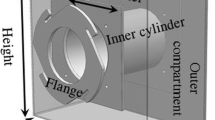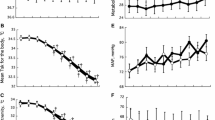Summary
To study the role of venous return from distal parts of the extremities in influencing heat loss from the more proximal parts, changes in mean skin temperature (¯T sk) of the non-exercising extremities were measured by color thermography during leg and arm exercise in eight healthy subjects. Thirty minutes of either leg or arm exercise at an ambient temperature (T a) of 20° C or 30° C produced a greatly increased blood flow in the hand or foot and a great increase in venous return through the superficial skin veins of the extremities. During the first 10 min of recovery from the exercise, blood flow to and venous return from the hand or foot on the tested side was occluded with a wrist or ankle cuff at a pressure of 33.3 kPa (250 mm Hg), while blood flow to the control hand or foot remained undisturbed. During the 10-min wrist occlusion, ¯T sk increased significantly from 28.3°±0.41° C to 30.1°±0.29° C in the control forearm, but remained at nearly the same level (28.0°±0.34° C to 28.2°±0.25° C) in the occluded forearm. In the legs, although ¯T sk on both sides was virtually identical (32.0°±0.31° C, control vs 32.0°±0.36° C, tested) before occlusion, ¯T sk on the control side (32.6°±0.27° C) was significantly higher than that on the tested side (32.2°±0.21° C) after ankle occlusion. As monitored by a laser-Doppler flowmeter, skin blood flow in both forearms and legs did not increase but rather decreased during the 30-min recovery. Thus, the increase in ¯T skin the control forearm or leg cannot be explained by the change in forearmor leg-skin blood flow. We estimated the contribution of the heat transferred from the venous blood of the hand to be 89% of the increase in heat loss from the forearm during occlusion atT a of 20° C, and to be 67% from the occluded leg atT a of 30° C. The present results suggest that heat loss from proximal parts of the extremities is greatly affected by the change in blood flow through the distal parts of the extremities, and such venous blood flow plays an important role in the regulation of heat dissipation during exercise in cool (20° C) to warm (30° C) environments.
Similar content being viewed by others
References
Aschoff J, Wever R (1959) Wärmeaustausch mit Hilfe des Kreislaufes. Dtsch Med Wochenschr 84:1509–1517
Aulick LH, Robinson S, Tzankoff SP (1981) Arm and leg intravascular temperatures of men during submaximal exercise. J Appl Physiol Respir Environ Exerc Physiol 51:1092–1097
Coffman JD, Cohen AS (1971) Total and capillary finger tip blood flows in Raynaud's phenomenon. N Engl J Med 285:259–263
Cooper T, Randall WC, Hertzman AB (1959) Vascular convection of heat from active muscle to overlying skin. J Appl Physiol 14:207–211
Grant RT, Pearson RSB (1938) The blood circulation in the human limb; observations on the difference between the proximal and distal parts and remarks on the regulation of body temperature. Clin Sci 3:119–139
Hirata K, Nagasaka T, Hirai A, Hirashita M, Takahata T, Nunomura T (1986) Effects of human menstrual cycle on thermoregulatory vasodilation during exercise. Eur J Appl Physiol 54:559–565
Holloway GA Jr, Watkins DW (1977) Laser Doppler measurement of cutaneous blood flow. J Invest Dermatol 69:306–309
Honda N (1962) Temperature compensation for mercury strain gauge used in plethysmography. J Appl Physiol 17:572–574
Johnson JM, Rowell LB (1975) Forearm skin and muscle vascular responses to prolonged leg exercise in man. J Appl Physiol 39:920–924
Johnson JM, Taylor WF, Shepherd AP, Park MK (1984) Laser-Doppler measurement of skin blood flow: comparison with plethysmography. J Appl Physiol Respir Environ Exerc Physiol 56:798–803
Nadel ER (1979) Temperature regulation. In: Strauss RH (ed) Sports medicine and physiology. Saunders, Philadelphia, pp 130–146
Nakayama T, Ohnuki Y, Niwa K (1977) Fall in skin temperature during exercise. Jpn J Physiol 27:423–437
Nilsson GE, Tenland T, Öberg PA (1980a) A new instrument for continuous measurement of tissue blood flow by light beating spectroscopy. IEEE Trans Biomed Eng BME-27:12–19
Nilsson GE, Tenland T, Öberg PA (1980b) Evaluation of a laser Doppler flowmeter for measurement of tissue blood flow. IEEE Trans Biomed Eng BME-27:597–604
Öberg PA, Nilsson GE, Tenland T, Holström A, Lewis DH (1979) Use of a new laser Doppler flowmeter for measurement of capillary blood flow in skeletal muscle after bullet wounding. Acta Chir Scand [Suppl] 489:145–150
Rübsamen K, Hales JRS (1984) Role of arteriovenous anastomoses in determining heat transfer across the hindleg skin of sheep. In: Hales JRS (ed) Thermal Physiology. Raven Press, New York, pp 259–262
Säumet JL, Dittmar A, Leftheriotis G (1986) Non-invasive measurement of skin blood flow: comparison between plethysmography, laser-Doppler flowmeter and heat thermal clearance method. Int J Microcirc Clin Exp 5:73–83
Sherman JL (1963) Normal arteriovenous anastomoses. Medicine (Baltimore) 42:247–267
Smits GJ, Roman RJ, Lombard JH (1986) Evaluation of laser-Doppler flowmetry as a measure of tissue blood flow. J Appl Physiol 61:666–672
Thoresen M, Walløe L (1980) Skin blood flow in humans as a function of environmental temperature measured by ultrasound. Acta Physiol Scand 109:333–341
Veghte JH, Adams WC, Bernauer EM (1979) Temperature changes during exercise measured by thermography. Aviat Space Environ Med 50:708–713
Wenger CB, Roberts MF, Stolwijk JAJ, Nadel ER (1975) Forearm blood flow during body temperature transients produced by leg exercise. J Appl Physiol 38:58–63
Whitney RJ (1953) The measurement of volume changes in human limbs. J Physiol (London) 121:1–27
Author information
Authors and Affiliations
Rights and permissions
About this article
Cite this article
Hirata, K., Nagasaka, T. & Noda, Y. Venous return from distal regions affects heat loss from the arms and legs during exercise-induced thermal loads. Europ. J. Appl. Physiol. 58, 865–872 (1989). https://doi.org/10.1007/BF02332220
Accepted:
Issue Date:
DOI: https://doi.org/10.1007/BF02332220




